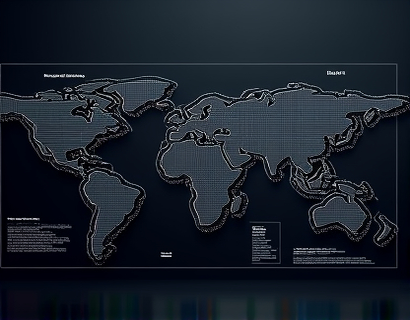Unlocking Complex System Insights: Advanced Software for Graph Theory and Fluid Dynamics Research
In the realm of complex system analysis, graph theory and fluid dynamics stand out as critical fields driving innovation and discovery. Researchers and engineers in these domains face unique challenges due to the intricate nature of the systems they study. To address these challenges, cutting-edge software solutions have emerged, designed to streamline data analysis and enhance visualization. These tools are pivotal in unlocking deeper insights and optimizing performance in mathematical modeling and fluid mechanics.
Graph Theory Software: A Powerhouse for Network Analysis
Graph theory, a branch of mathematics that studies the properties of graphs, is fundamental in understanding and analyzing complex networks. In various applications, from social networks to transportation systems, graph theory provides a robust framework for modeling relationships and interactions. Advanced software for graph theory offers a suite of tools that facilitate the manipulation and analysis of graph data.
One of the key features of this software is its ability to handle large-scale graphs efficiently. Researchers can input vast amounts of data and perform complex operations such as shortest path calculations, network flow analysis, and community detection with ease. The software employs sophisticated algorithms to ensure that computations are not only fast but also accurate, allowing for real-time analysis and dynamic updates.
Visualization is another critical aspect of graph theory software. Complex networks can be challenging to interpret, but advanced visualization tools transform data into intuitive and informative graphics. Nodes and edges can be color-coded, sized, and positioned to highlight important features and patterns. Interactive visualizations enable users to explore different aspects of the graph, zoom in on specific regions, and drill down into detailed information.
Fluid Dynamics Software: Mastering the Art of Fluid Simulation
Fluid dynamics, the study of fluids in motion, is essential in fields ranging from aerospace engineering to environmental science. Simulating fluid behavior accurately is crucial for designing efficient systems and predicting natural phenomena. Software dedicated to fluid dynamics provides powerful tools for solving the complex equations that govern fluid flow.
Computational Fluid Dynamics (CFD) software is at the forefront of this field, enabling researchers to model and simulate fluid behavior under various conditions. These tools solve the Navier-Stokes equations and other relevant partial differential equations, providing detailed insights into flow patterns, pressure distributions, and turbulence. The software supports both steady-state and transient analyses, allowing for comprehensive studies of fluid systems.
One of the standout features of modern CFD software is its ability to handle multi-physics simulations. This means that researchers can analyze the interplay between fluid dynamics and other physical phenomena, such as heat transfer and structural mechanics. Such integrated approaches are vital for developing advanced technologies and understanding complex systems.
Enhanced Data Analysis and Processing
Both graph theory and fluid dynamics software prioritize efficient data processing and analysis. High-performance computing capabilities ensure that even the most demanding simulations run smoothly and quickly. Parallel processing and optimized algorithms are employed to maximize computational efficiency, reducing the time required for complex calculations.
Data preprocessing is another area where these tools excel. Raw data from experiments or simulations often require cleaning and normalization before analysis. Advanced software includes preprocessing modules that automate these tasks, ensuring that the data is ready for accurate analysis. This not only saves time but also reduces the potential for human error.
Advanced Visualization Techniques
Visualization plays a crucial role in understanding complex systems. Advanced software for graph theory and fluid dynamics offers a range of visualization techniques tailored to the specific needs of each field. For graph theory, visualization tools can represent nodes and edges in 2D or 3D, allowing for a more intuitive understanding of network structures.
In fluid dynamics, visualization goes beyond static images. Dynamic visualization techniques, such as animation and time-lapse videos, help researchers observe the evolution of fluid flow over time. Color maps and vector fields are used to represent velocity, pressure, and other flow properties, making it easier to identify critical features and anomalies.
Interactive visualization is a game-changer, enabling users to manipulate the visualization parameters in real-time. This interactivity is particularly useful for exploring large datasets and identifying patterns that might not be apparent in static representations. Users can adjust parameters such as resolution, scale, and perspective to gain deeper insights into the data.
Integration and Compatibility
Modern software solutions are designed with integration and compatibility in mind. They can seamlessly integrate with other tools and platforms commonly used in research and engineering workflows. This interoperability ensures that data can be easily imported and exported, facilitating a smooth transition between different stages of the research process.
Support for standard file formats, such as CSV, NetCDF, and STL, ensures compatibility with a wide range of data sources. Additionally, APIs and scripting capabilities allow power users to customize the software to meet specific research needs. This flexibility is essential for researchers who require tailored solutions for their unique projects.
User-Friendly Interfaces and Comprehensive Documentation
Despite the complexity of the tasks they perform, advanced software for graph theory and fluid dynamics is designed to be user-friendly. Intuitive interfaces guide users through the analysis process, reducing the learning curve and making these tools accessible to a broader audience.
Comprehensive documentation and support resources are also provided, ensuring that users can fully leverage the software's capabilities. Tutorials, user manuals, and online forums offer valuable assistance, helping users overcome challenges and maximize the software's potential. This support is crucial for researchers who may not have extensive experience with advanced computational tools.
Driving Innovation and Optimization
The impact of advanced software in graph theory and fluid dynamics extends beyond individual research projects. By providing precise analysis and unparalleled insights, these tools drive innovation and optimization across entire fields. Researchers can identify new patterns, test hypotheses, and develop novel solutions that were previously unattainable.
In graph theory, advanced software enables the exploration of complex networks in ways that were once impossible. This has led to breakthroughs in areas such as social network analysis, traffic flow optimization, and biological network modeling. Similarly, in fluid dynamics, the ability to simulate and analyze complex flows has revolutionized industries such as aerospace, automotive, and environmental engineering.
Moreover, the collaborative nature of these software tools fosters a community of researchers and engineers who can share insights, methodologies, and best practices. This collective advancement accelerates the pace of discovery and pushes the boundaries of what is possible in mathematical modeling and fluid mechanics.
Conclusion
In conclusion, the software solutions for graph theory and fluid dynamics represent a significant leap forward in the field of complex system analysis. By streamlining data analysis, enhancing visualization, and providing powerful analytical capabilities, these tools empower researchers and engineers to unlock deeper insights and optimize performance in their respective domains. As technology continues to evolve, the potential for further advancements and innovations remains vast, promising a future where complex systems are understood and harnessed to their fullest potential.










































